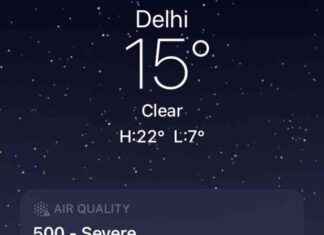Lightning ice, snow, sleet and sleet caused an uncomfortable weekend in Bavaria – and in places chaos on the streets. Mass accidents on Bavarian motorways resulted in damage amounting to several hundred thousand euros.
Due to a mass accident following lightning ice, the A8 south of Munich was completely closed for several hours on Saturday. According to police, there was an accident involving eight vehicles at midday near Bernauer Berg due to weather conditions. Because cars and car parts were thrown into the oncoming lane, the A8 had to be closed in both directions for some time. The highway was completely reopened around 4 p.m. No one was injured in the mass accident, a police spokesman said. The police estimate the damage at 200,000 to 250,000 euros.
15 people were injured in a pile-up in slippery conditions on Autobahn 70 in Upper Franconia. According to a police spokeswoman, 29 vehicles, including cars and a long-distance bus, were involved in the accident on Saturday morning. 14 vehicles were involved on the road towards Bamberg and 15 in the opposite direction to Bayreuth, including, according to police, a truck and a coach.
The police cited “heavy rain and hail combined with excessive speed” and insufficient safety distance as the cause of the accident. According to initial estimates, the amount of damage is between 250,000 and 300,000 euros. A large number of emergency services were on site, including 130 firefighters, six emergency doctors and 70 paramedics. Three rescue helicopters and a police helicopter were in use, as well as 15 ambulances. 32 people were looked after and cared for at the Thurnau fire station. The A70 was closed in both directions between Schirradorf and Thurnau-West.
On the A94 between the Pastetten and Lengdorf junctions in Upper Bavaria, a heavy hailstorm suddenly set in in the afternoon and the roads were covered in white within seconds, as the Hohenbrunn traffic police station announced. Several cars skidded in the direction of Passau and two cars ended up in a ditch. Another car slid against another car. There was also an accident in the same place on the opposite lane: a car slipped and hit the right guardrail. There was a total damage of around 55,000 euros, it was said. Nobody got hurt. The right lane in the direction of Passau was closed for around two hours.
Two drivers were seriously injured in a head-on collision on a rain-soaked road in Swabia. A 20-year-old drove his car into the opposite lane in a long right-hand bend near Eppishausen (Unterallgäu district), as the police announced on Saturday. His vehicle collided head-on with the oncoming car of a 58-year-old.
The snowfall limit should drop to 400 to 500 meters by Sunday, the German Weather Service (DWD) announced on Saturday. Up to 15 centimeters of snow can be expected in the low mountain ranges. In the Alps above 1000 meters there could be up to 30 centimeters of fresh snow. It was said that persistent snowfall was possible, especially in northern Franconia, on Sunday night. According to the forecast, temperatures are likely to be between 3 degrees below and 2 degrees above zero at night.
The DWD is expecting further snow and rain showers for Sunday, although it will likely be dry and partly sunny in eastern Bavaria in the afternoon, with temperatures of up to 9 degrees. The night of Monday is expected to become increasingly dry overall, with widespread frost and temperatures down to 5 degrees below zero.


















